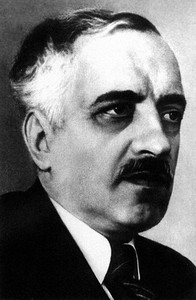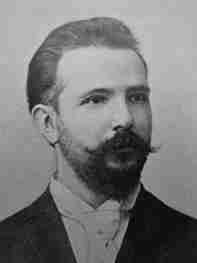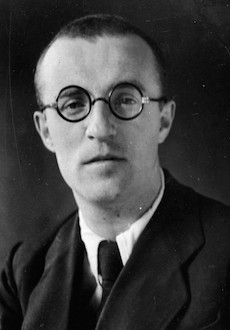
Boris Nikolayevich Lyatoshinsky (Boris Lyatoshinsky) |
Boris Lyatoshinsky

The name of Boris Nikolaevich Lyatoshinsky is associated not only with a huge and, perhaps, the most glorious period in the development of Ukrainian Soviet music, but also with the memory of a great talent, courage and honesty. In the most difficult times of his country, in the most bitter moments of his own life, he remained a sincere, courageous artist. Lyatoshinsky is primarily a symphonic composer. For him, symphonism is a way of life in music, a principle of thinking in all works without exception – from the largest canvas to a choral miniature or an arrangement of a folk song.
The path of Lyatoshinsky in art was not easy. A hereditary intellectual, in 1918 he graduated from the Faculty of Law of Kyiv University, a year later – from the Kyiv Conservatory in the composition class of R. Gliere. The turbulent years of the first decade of the century were also reflected in the first works of the young composer, in which his affections are already clearly felt. The First and Second String Quartets, the First Symphony are full of stormy romantic impulses, the exquisitely refined musical themes date back to the late Scriabin. Great attention to the word – the poetry of M. Maeterlinck, I. Bunin, I. Severyanin, P. Shelley, K. Balmont, P. Verlaine, O. Wilde, ancient Chinese poets was embodied in equally refined romances with complicated melody, an extraordinary variety of harmonic and rhythmic means. The same can be said about the piano works of this period (Reflections, Sonata), which are characterized by sharply expressive images, aphoristic laconism of themes and their most active, dramatic and effective development. The central composition is the First Symphony (1918), which clearly manifested a polyphonic gift, a brilliant command of orchestral timbres, and the scale of ideas.
In 1926, the Overture appeared on four Ukrainian themes, marking the beginning of a new period, which is characterized by close attention to Ukrainian folklore, penetration into the secrets of folk thinking, into its history, culture (the operas The Golden Hoop and The Commander (Shchors) ); cantata “Zapovit” on T. Shevchenko; marked by the finest lyricism, arrangements of Ukrainian folk songs for voice and piano and for choir a cappella, in which Lyatoshinsky boldly introduces complex polyphonic techniques, as well as unusual for folk music, but extremely expressive and organic harmonies). The opera The Golden Hoop (based on the story by I. Franko) thanks to a historical plot from the XNUMXth century. made it possible to paint images of the people, and tragic love, and fantastic characters. The musical language of the opera is just as diverse, with a complex system of leitmotifs and continuous symphonic development. During the war years, together with the Kyiv Conservatory, Lyatoshinsky was evacuated to Saratov, where hard work continued under difficult conditions. The composer constantly collaborated with the editors of the radio station. T. Shevchenko, who broadcast her programs for residents and partisans of the occupied territory of Ukraine. In the same years, the Ukrainian Quintet, the Fourth String Quartet, and the Suite for String Quartet on Ukrainian folk themes were created.
The post-war years were especially intense and fruitful. For 20 years, Lyatoshinsky has been creating beautiful choral miniatures: on st. T. Shevchenko; cycles “Seasons” on st. A. Pushkin, at the station. A. Fet, M. Rylsky, “From the Past”.
The Third Symphony, written in 1951, became a milestone work. Its main theme is the struggle between good and evil. After the first performance at the plenum of the Union of Composers of Ukraine, the symphony was subjected to unfairly harsh criticism, typical for that time. The composer had to remake the scherzo and the finale. But, fortunately, the music remained alive. By the embodiment of the most complex concept, musical thought, dramatic solution, Lyatoshinsky’s Third Symphony can be put on a par with D. Shostakovich’s Seventh Symphony. 50-60s marked by the composer’s great interest in Slavic culture. In search of common roots, the commonality of the Slavs, Polish, Serbian, Croatian, Bulgarian folklore is closely studied. As a result, the “Slavic Concerto” for piano and orchestra appears; 2 mazurkas on Polish themes for cello and piano; romances on st. A. Mitskevich; symphonic poems “Grazhina”, “On the banks of the Vistula”; “Polish Suite”, “Slavic Overture”, Fifth (“Slavic”) Symphony, “Slavic Suite” for symphony orchestra. Pan-Slavism Lyatoshinsky interprets from high humanistic positions, as a community of feelings and understanding of the world.
The composer was guided by the same ideals in his pedagogical activity, bringing up more than one generation of Ukrainian composers. Lyatoshinsky’s school is, first of all, the identification of individuality, respect for a different opinion, freedom of search. That is why his students V. Silvestrov and L. Grabovsky, V. Godzyatsky and N. Poloz, E. Stankovich and I. Shamo are so unlike each other in their work. Each of them, having chosen his own path, nevertheless, in each of his works, remains true to the main precept of the Teacher – to remain an honest and uncompromising citizen, a servant of morality and conscience.
S. Filstein





